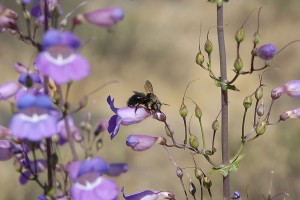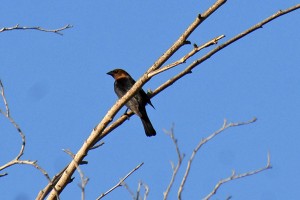Just in case you were fantasizing about nature’s creatures living in perfect harmony, you can get a dose of reality from two recently-spotted BFS denizens, who are clearly looking out for #1…
Exhibit 1 is the Brown-headed Cowbird:
Brown-headed Cowbirds, Molothrus ater, are small blackbirds that do not build their own nests. Instead, females lay their eggs in the nests of other bird species, and cowbird chicks are raised by the involuntary ‘foster parents’. Cowbird chicks have been successfully raised by more than 150 different species of birds. And female Brown-headed Cowbirds can lay more than three dozen eggs in a single summer!
Such ‘brood parasitism’ is deleterious to the birds that are ‘hosting’ the Cowbird eggs and chicks. While it can significantly decrease host species’ reproductive success locally, the impact is usually small at the population level.
For more information, see:
- All About Birds: Brown-headed Cowbird.
http://www.allaboutbirds.org/guide/Brown-headed_Cowbird/id - Audubon Society: Cowbirds and Conservation.
http://www.audubon.org/bird/research/
Exhibit 2 is the Mountain Carpenter Bee:

A Mountain Carpenter Bee robbing nectar from a Penstemon spectabilis flower, 7 May 2009. Photo by Tad Beckman.
This Mountain Carpenter Bee, Xylocopa tabaniformis, is piercing the nectary of a Royal Penstemon (Penstemon spectabilis) flower to suck the nectar from the outside, a process known as ‘nectar-robbing’. Most bees, like the unidentified native bee shown below, crawl into the Penstemon flowers to get nectar, in the process picking up pollen that is transferred to other flowers. Nectar-robbing bees, however, take the nectar, but provide no pollination service in return, and they have been assumed to be detrimental to the plant. Besides direct effects, nectar removal can discourage the normal pollinators from visiting the robbed flowers. Charles Darwin wrote that “all plants must suffer in some degree when bees obtain their nectar in a felonious manner by biting holes through the corolla.”
Recent research, however, suggests that some nectar-robbing bees may actually benefit host plants. Some do pick up pollen without entering the corolla, and thus provide some cross-pollination. In addition, decreasing the nectar content of flowers can cause the ‘legitimate’ pollinators to fly longer distances and visit more flowers, thus increasing gene flow.
In the case of the Mountain Carpenter Bee and the Royal Penstemon, the jury is out. Perhaps their relationship could be the subject of a future study.
For more information, see:
- Maloof, J.E., and D.W. Inouye. 2000. Are nectar robbers cheaters or mutualists? Ecology 81: 2651-2661.
http://www.esajournals.org/doi/abs/10.1890/0012-9658(2000)081%5B2651%3AANRCOM%5D2.0.CO%3B2 - Kimball, S., and P. Wilson. 2009. The Insects That Visit Penstemon Flowers. Bulletin of the American Penstemon Society 68: 20-27
http://www.csun.edu/~hcbio028/PollinatorGuide.pdf

